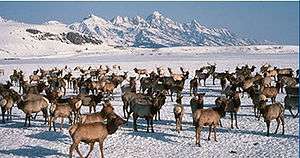National Elk Refuge
| National Elk Refuge | |
|---|---|
|
IUCN category IV (habitat/species management area) | |
|
Wetlands on the National Elk Refuge | |
 | |
| Location | Teton County, Wyoming, United States |
| Nearest city | Jackson, WY |
| Coordinates | 43°28′49″N 110°44′53″W / 43.48028°N 110.74806°WCoordinates: 43°28′49″N 110°44′53″W / 43.48028°N 110.74806°W |
| Area | 25,000 acres (101 km2) |
| Established | 1912 |
| Governing body | U.S. Fish and Wildlife Service |
| Website | National Elk Refuge |
The National Elk Refuge is located in the U.S. state of Wyoming and was created in 1912 to protect habitat and provide sanctuary for one of the largest elk (also known as the wapiti) herd on Earth. The refuge borders the town of Jackson, Wyoming on the northeast while Bridger-Teton National Forest is to the east and Grand Teton National Park borders the refuge to the north. It is home to an average of 7,500 elk each winter. The refuge is managed by the U.S. Fish and Wildlife Service, an agency of the U.S. Department of the Interior.
Elk migrate from as far away as southern Yellowstone National Park and historically migrated south of the present location of the refuge into southwestern Wyoming during the fall, wintering on grassy plains that were usually snowfree most of the winter. During the spring, the herd would follow the retreating snows back into the Yellowstone National Park region. The original size of the elk herd has been estimated to have been in excess of 25,000. The expansion of the town of Jackson blocked off the migration route by the end of the 19th century and the elk herd was severely reduced in size due to the hostile climate and lack of food supply.

A movement to protect and enlarge the remaining herd was commenced in the early 1900s, resulting in the creation of the refuge. The elk herd is kept alive during the hard winters of Jackson Hole through feeding and culling of the herd, a lottery based hunting permit program, which is highly regulated. The elk have antlers which are shed each year and the Boy Scouts of America have been collecting the antlers under permit since the 1950s and selling them at auction under agreement that 75% of the proceeds are returned to the refuge to feed, research and manage the herd to assure its survival. Ten to eleven thousand pounds (4,500 to 5,000 kg) of antlers are auctioned each year. The increase in value has resulted in a commensurate rise in antler theft.[1]
The refuge also provides horse drawn sleigh rides to the public during the winter months so that visitors have the opportunity to see portions of the herd up close. The furthest consistent migration of elk to the refuge is currently from the southern portion of Yellowstone National Park,[2] making it the second longest ungulate migration in the lower 48 states. (The migration of pronghorn between the Green River basin and Jackson Hole in Wyoming is longer).
The refuge is nearly 25,000 acres (101 km2) of meadows and marshes along the valley floor, sagebrush and rock outcroppings along the mountain foothills. The largest single herd of bison under federal management, comprising 1,000 plus individuals, also winter on the refuge. Bighorn sheep can be found here, along with pronghorn, mule deer and even a few trumpeter swans along Flat Creek, which flows out of the refuge south into the town of Jackson. Rare sightings of wolves and grizzly bears have occurred, and a total of 47 mammal species and 147 bird species have been documented on the refuge.
References
- ↑ "Boy Scouts Assist with Antler Collection" (PDF). National Elk Refuge News. USFWS. 30 April 2007. Archived from the original (PDF) on 3 December 2007. Retrieved 4 November 2007.
- ↑ Smith, Bruce L.; Robbins, Russell L. (1994). Migrations and Management of the Jackson Elk Herd (PDF). Resource Publication 199 (Report). DOI. ISSN 0163-4801. Retrieved 8 August 2016.
External links
- "National Elk Refuge". United States Fish and Wildlife Service.
- National Elk Refuge: Refuge Road Wildlife Viewing Guide U.S. Fish and Wildlife Service